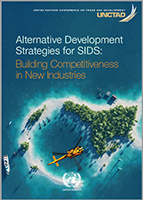Small Island Developing States (SIDS) face severe structural challenges to their sustainable development. The United Nations recognises 38 SIDS, which include some of the poorest and most isolated countries in the world, with relatively small populations and narrow endowments of land and natural resources.
The need to reduce vulnerability and build resilience to external shocks has guided collective efforts by SIDS and the international community. As part of the 2030 Agenda for Sustainable Development, the United Nations devoted an intergovernmental process to assisting SIDS, from which the most recent outcome document is the wide-ranging 2014 SIDS Accelerated Modalities of Action (SAMOA) Pathway, intended to guide international action towards sustainable development in SIDS.
This paper aims to build on the parts of the Pathway devoted to building resilient economies in SIDS.2 Economic development strategies are an important piece of the resilience-building agenda. They provide a blueprint for governments and incentives for the private sector to invest in new industries and infrastructure, ideally spurring a self-reinforcing cycle of economic growth and structural transformation, yielding a resilient economy – a pillar of any sustainable development plan.
This paper proposes a two-part analysis.
Section 1 builds the case for economic development strategies as an important part of resilience-building in SIDS and the need to identify alternative strategies adapted to their context.
Section 2 then proposes a simple framework to evaluate: what exists in terms of SIDS’ endowments and economic structures, to frame how SIDS are positioned to capitalise on future opportunities, in the context of, for example, global value chains and the Fourth Industrial Revolution.
This paper does not presume to prescribe short-term fixes to the unique challenges facing SIDS. Instead, we intend for our analysis and recommendations to reinforce an ongoing strategic planning process in SIDS, towards long-term, sustainable economic development. In this respect, the paper is a first step towards more detailed analysis, policy advice and technical assistance on formulating development strategies adapted to SIDS’ particular needs.

